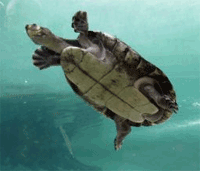 Studies on the fossils prove that the reptiles were present on the earth about 320 million years ago.
Studies on the fossils prove that the reptiles were present on the earth about 320 million years ago.
Turtles are categorized under the class Reptiles and their fossils, unearthed from various parts of the world, have confirmed their presence approximately 250 million years before.
Reptiles are one step superior to the amphibians (the class of animals which are aquatic as well as terrestrial) in the evolutionary process, as they were evolved from the latter.
Snakes, lizards, alligators, turtles…all these are examples of reptiles. Among them, turtles are very commonly mistaken as amphibians because of the nature of their habitation.
Aquatic turtles live in various water bodies like bogs, woodlands, pasture edges, sea, river, and ponds while the terrestrial ones (tortoise) live on land, sometimes even in deserts too. This feature gives them a characteristic similarity to an amphibian.
Primitive turtles were bigger in size, around 20 inches (50 cm) more than the present ones. Other than the beak; they had some small teeth too.
There are several types of turtles, among them Leatherback sea turtles of the present day are the largest turtle which can grow up to 5ft in length and 800 kg or 1,800 lbs in weight.
Unlike amphibians, turtle’s eggs do not need water for hatching. Turtles can live on the land (Terrestrial turtles or Tortoise)), in the sea (Turtle), or in the brackish water (Terrapin).
Like other reptiles, turtles are also cold-blooded animals and hence require very less energy for their survival. The female water turtles dig their nesting burrows and lay their eggs on the sea shores or the river banks and then cover them with sand and go back to the sea.
Both turtles and tortoises (land turtles) are slow growers. The hatchling mortality is also very high and only one among thousand hatchlings can survive to grow. But their life span can be above 100 years or more!
The unique exoskeleton of a turtle is made up of a hard protective shell (Top part –Carapace, Lower part–plastron). In adversity, they pull their body in it. They are carnivores and can become good pets too.
Turtles play an important role in the ecological conservation by forming a biological relationship with different other types of flora and fauna.
Due to uncontrolled killing of turtles, these timid, harmless and small creatures have become endangered nowadays. More over, the ecosystems would be severely damaged if the tortoise does not survive.
Think before you act….!!

